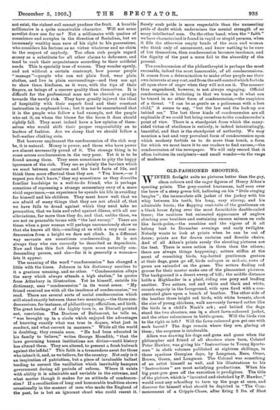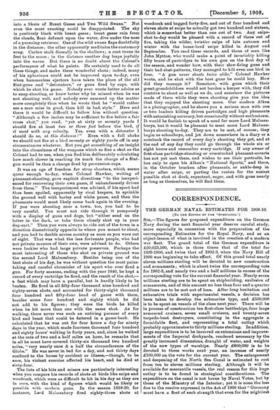OLD-FASHIONED SHOOTING.
WINTER firelight suits no pictures better than the gay, clean colours and the eager figures of Henry Al ken's sporting prints. The grey-coated huntsman, half seen over the brow of a steep green hill, hallooing on his "little singing beagles "; the immaculate silk jacket of the jockey with his whip between his teeth, his long, easy stirrup, and hie admirable boots; the flapping coat-tails of the gentleman on a black horse flying over the most formidable double-railed fence ; the cautious but animated appearance of anglers climbing over boulders and sustaining unseen salmon on rods like larch-poles,—the sunshine and the vigour of it all belong best to December evenings and early twilights. Nobody wants to look at prints when he can be out of doors; prints are for drawn curtains and fireside chairs. And of all Alken's prints surely the shooting pictures are the best. There is more action in them than the others; there are always things happening ; setters stiffen at the scent of crouching birds, top-hatted gentlemen gesture at their dogs, guns go off, birds collapse in mid-air, rows of game are extended on the grass. The setters finding red grouse for their master make one of the pleasantest pictures. The background is a desert sweep of hill; the middle distance holds a Highlander in a plaid, riding one pony and leading another. Two setters, red and white and black and white, crouch eagerly in the foreground, with eyes fixed with a con- centrated glare upon a bunch of heather. The other side of the heather three bright red birds, with white breasts, about the size of young chickens, walk nervously forward rather like the birds in a child's Noah's ark ; and behind the dogs stand the two shooters, one bi a short fawn-coloured jacket, and the other voluminous in bottle-green. Will the birds rise to the right or left ? Will the fawn-coloured gun get one with each barrel ? The dogs remain where they are, glaring at them ; the suspense is intolerable.
Aiken was drawing his dogs and guns and game when the philosopher and friend of all shooters since born, Colonel Peter Hawker, was giving his "Instructions to Young Sports- men" in cloth volumes published at eighteen shillings, in those spacious Georgian days, by Longman, Rees, Orme, Brown, Green, and Longman. The Colonel was something of an artist himself as well, and his illustrations to his "Instructions" are most satisfying productions. When his big punt-gun goes off the execution is prodigious. The title of the picture, which is "invented and sketched by P. Hawker," would send any schoolboy to turn up the page at once, and discover for himself what should be depicted in "The Com- mencement of a Cripple-Chase, after firing 2 lbs. of Shot into a Skein of Brent Geese and Two Wild Swans." Not even the most exacting could be disappointed. The sky is positively black with brent geese ; brent geese rain from the clouds, float defunct upon the water, dive under the nose of a pursuing retriever. One of the wild swans flaps doubtfully in the distance; the other apparently meditates the customary song. Curlew stalk dismally in the shallows; a coot turns its feet to the moon ; in the distance another dog leaps joyfully into the waves. But there is no doubt about the Colonel's performance of what he paints. He certainly used to do all these things, and make these wonderful shots ; indeed, many of his aphorisms could not be improved upon to-day, even when hammerless ejectors have taken the place of the old flint-guns and "detonators," or guns fired by caps, with which be shot his game. Nobody ever wrote better advice as to snap-shooting, or knew better why he missed when he was not shooting well, and nobody ever summed up the matter more completely than when he wrote that he "would rather see a man miss in good, than kill in bad, style." Here and there it would be difficult to follow him without question.
"Although a few inches may be sufficient to fire before a fair cross shot," you read, "yet at sixty or seventy yards I should fire at least two or three feet before the bird, if
it went with any velocity. Yes, even with a detonator I should do so, at this distance !" Even with a full choke we should not fire at a bird seventy or eighty yards off in any circumstances whatever. But you get something of an insight into the clumsiness of the weapons which so fine a shot as the Colonel had to use, when you find him deliberately calculating how much slower in reaching its mark the charge of a flint. gun would be than a charge fired by percussion-caps.
It was an age of freedom for stray shooters, which seems queer enough to-day, when Colonel Hawker, writing of pheasant-shooting, gave explicit directions "to the inexperi- enced for recovering their own game, if unhandsomely driven from them." The inexperienced was advised, if his sport had thus been spoiled, apparently by rival keepers, to sprinkle the ground well with barley and white pease, and then the pheasants would most likely come back again in the evening.
If you were shooting near a town, too, you had to be very careful. You must not ride through it pompously with a display of guns and dogs, but 'either send on the latter in the dark, or take them closely shut up in your dog-cart." Then you were always to ride out of the town in a direction diametrically opposite to where you meant to shoot, and you had to double across country as soon as you were out of sight. That was what the less fortunate people, who bad not private manors of their own, were advised to do. Others were luckier who bad large private preserves. Perhaps the most interesting of those who shot on private ground was the second Lord Malmesbury. Besides being one of the best shots of his day, he was without question the most pains- taking and careful chronicler of his sport who ever fired a gun. For forty seasons, ending with the year 1840, he kept a record of every cartridge he fired, and the result of the shot,— a feat which may have a parallel, but is hardly likely to be beaten. He fired in all fifty-four thousand nine hundred and eighty-seven shots, and accounted for thirty-eight thousand four hundred and fifty-four head of game with them, besides some four hundred and eighty which be did not add to his figures ; they were the birds he killed when be hit more than one with the same shot. As for walking, there never was such an untiring pursuer of every bird and beast that could be entered in a game-book. He calculated that he was out for four hours a day for ninety days in the year, which made fourteen thousand foSir hundred and eighty hours' walking in forty years, and, since be walked at the rate of two and a half miles an hour, he remarks that in all he must have covered thirty-six thousand two hundred miles, "very nearly once & a half the circumference of the Globe." He was never in bed for a day, and not thirty days confined to the house by accident or illness,—though, to be sure, his violent exercise affected his heart, and he died at sixty-four.
. The lists of his hits and misses are particularly interesting when you compare his records of shots at birds like snipe and woodcock, which were as difficult to hit in his day as they are in ours, with the kind of figures which would be likely or possible with modern guns. In the season 1819-20, for instance, Lord Malinesbury fired eighty-three shots at
woodcock and bagged forty-five, and out of four hundred and eleven shots at snipe he actually got two hundred and sixteen, which is somewhat better than one out of two. Any snipe- shot to-day would be pleased with a record of three out of five, taking the wilder, twistier snipe of late autumn and winter with the home-bred snipe killed in August and September. You read these records, and those of men like John Mytton, who would make a point of invariably killing fifty brace of partridges to his own gun on the first day of the season, and wonder how, with their slow-firing guns and their bad shot-patterns, they managed to kill even one bird in four. "A gun never shoots twice alike," Colonel Hawker wrote, and he shot with the best guns he could buy. How did they manage it ? Somehow, with guns which their great-grandchildren would not burden a keeper with, they did contrive to shoot as well as we do, and somehow the pictures made of them while they were shooting give you the idea that they enjoyed the shooting more. Our modern Aiken is a photographer, and he shows you a serious man with one or two loaders killing driven partridges and high pheasanh3 with astonishing accuracy, but occasionally without enthusiasm:. It would be foolish to speak of a need for more Lord Malmes- burys, but it would be pleasant to meet more Lord Malmes- burys shooting to-day. They are to be met, of course; they begin as schoolboys, and jot down somewhere in a diary or a notebook the record of every day's shooting they get, and at the end of any day they could go through the whole six or eight hours and remember every cartridge. If any owner of float-c]ass partridge-shooting or overstocked pheasant-coverts has not yet met them, and wishes to see their portraits, he has only to open his Alken's "National Sports," and there, in the October bracken after pheasants, or ankle-deep in water after snipe, or parting the rushes for the easiest possible shot at duck, expectant, eager, and with guns nearly as long as themselves, he will find them.







































































 Previous page
Previous page